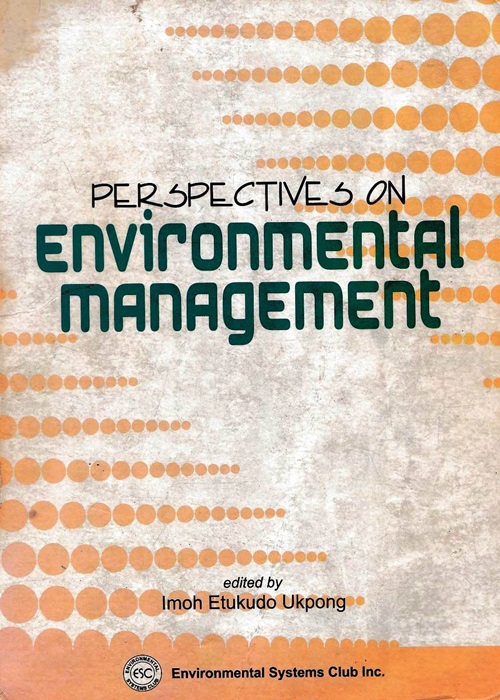Description
It was not intentional that Perspectives be written in the 10th year of the teaching of environmental management in the University of Uyo. It is coincidental or should I say a spontaneous reaction by the teachers who, over this period since 1998 have depended on piece meal literature search to update the information they have used since inception.
Sectoral literature on the environment is available, but found far apart, particularly in Nigeria. The massive details found in comprehensive environmental management handbooks have not found wide readership among students since they are compiled, in the first instance for those who are already professionals. In fact the readership of these books seems to be negligible among students in the country, and where available serve as occasional reference source for researchers. Perspectives is designed to bring the various aspects of the environment under one cover with a focus on the integration of the physical, “laboratory”, and anthropogenic environments, with man in the centre spread. As with the Postgraduate Diploma Programme in Environmental Management from which this book is
birthed, the approach is multidisciplinary and indeed interdisciplinary. But the strong human, spatial and interactive elements are derived from the social sciences, based on the concept of environment including man.
The chapters in this book overlap to some considerable extent. But then, this is the nature of the environment, particularly when handled from varying perspectives. The book volume is divided into five sections or books and attempts have been made to group related chapters together. It is desirable that Understanding the Physical and Human Environment forms the first section of the book since the environmental management programme was conceived as an all-comers affair from different disciplines. The intention of this section is to provide background knowledge on some physical and anthropogenic activities considered as primary to the generation of environmental impacts.
Book two is a short contribution, essentially environmental ethics, an aspect that is desirable to stimulate deep discourse and thinking, but which appears to have been neglected in some programmes. It is a relatively recent off-shoot of philosophy and is still being developed by our programme in the context of environmental thought in Nigeria. Book three explores environmental productivity by incorporating some basic aspects of ecological and resource management. This section is stretched to include biogeographical analysis and land resource evaluation. The section is definitive in many aspects, introducing the students to more comprehensive texts which hopefully they may read in the course of the programme or while doing research work.
The fourth book deals with the principles and techniques which environmental management
practitioners should be conversant with. The various field techniques are extracted and
discussed, including simple statistical and mathematical modeling, and the importance of the
Geographical Information System in environmental studies. The chapter on instrumental
techniques of laboratory analysis will acquaint readers on the analytical principles of some of
the most commonly used laboratory equipments in the environment domain.
Book five concludes this text by discussing the environmental management institutions,
policies, regulations and law, and other relevant instruments which the modern
environmental manager should be equipped with. Emphases have been placed on the
Nigerian environment although the basics are equally applicable elsewhere.
Several of the chapters in this book have been fleshed out with inserts, intended to add
reading value. I sincerely believe that this compilation will find wide readership, not only
among postgraduate students, but also among staff and undergraduate students who are
interested in the environment.
Imoh Etukudo Ukpong
TABLE OF CONTENTS
Acknowledgments ———————————————————— iii
Table of Content———————————————————— v
BOOK ONE
UNDERSTANDING THE PHYSICAL AND HUMAN ENVIRONMENT
1. Physical environmental components and processes
Imoh Ukpong—— ————————————————- 2
2. Aspects of environmental chemistry and biology
Essien Udosen——————————————————- 52
3. Air, soil and water quality – Peter Ogban———————— 94
4. Human environmental components and impacts
Ekong Daniel —————————————————– 131
BOOK TWO
PHILOSOPHICAL AND PSYCHOLOGICAL ASPECTS OF THE
ENVIRONMENT
5. Environmental ethics
Imoh Ukpong ——————————————————- 151
6. Environmental ethics and human behaviour in Nigeria
Edet Ikurekong ——————————————————– 160
Insert: Some issues in environmental psychology
Ekong Daniel———————————————————– 169
BOOK THREE
ENVIRONMENTAL PRODUCTIVITY AND EVALUATION
7. Ecological economics
Imoh Ukpong —————————— 178
8. Market failure and environmental degradation
Enobong Umobong —————————————————- 194
Insert: Environmental economics – Nsenam Udoaka————– 195
9. Environmental health
Emmanuel Udofia——————————————————- 209
10. Environmental resource management and evaluation
Imoh Ukpong————————————————————- 222
11. Biogeographical analysis and environmental ecology
Imoh Ukpong ————————————————————- 271
12. Introduction to land resources evaluation and management
Edet Ikurekong and Emmanuel Udofia——————————- 311
Insert: Definition and purpose of land reclamation
Imoh Ukpong ————————————————————- 312
————————————————————————– i
BOOK FOUR
PRINCIPLES, TECHNIQUES AND MODELS IN ENVIRONMENTAL
MANAGEMENT
13. Environmental management principles
Imoh Ukpong ————————————————————– 327
14. Basic Techniques in Environmental Analysis
Emmanuel Akpabio ——————————————————- 358
15. Statistical modeling for environmental analysis
Emmanuel Udofia ——————————————————— 399
16. Mathematical modeling for environmental analysis
Asuquo Eyo ————————————————————— 427
17. GIS and environmental monitoring
Joseph Udoh ————————————————————— 436
18. Instrumental techniques of chemical analysis
Aniefiok Ekop ————————————————————– 446
19. Planning and execution of modern water supply schemes
Eno Ukpong ———————————————————— 478
20 Choice and use of plant materials in landscaping
Enefiok Udoh ———————————————————– 510
BOOK FIVE
INSTITUTIONS, WASTE MANAGEMENT AND EVALUATION OF IMPACTS
21. Institutions and environmental management to Nigeria
Emmanuel Akpabio ——————————————————- 522
22. Introduction to Nigeria’s environmental policy
Imoh Ukpong ————————————————————— 536
23. Environmental regulations and law
Imoh Ukpong ————————————————————— 557
24. Environmental monitoring
Imoh Ukpong ————————————————————— 621
25. Environmental audit
Imoh Ukpong ————————————————————— 634
26. Waste Management
Emmanuel Udofia———————————————————- 659
Insert: Management of toxic wastes – Imoh Ukpong—————— 671
Insert: Management of radioactive wastes: Historical
antecedents and ecological impacts-Imoh Ukpong——————– 683
27. Impact evaluation and assessment -Essien Udosen——————– 695
Revision questions and exercises—————————————————— 744
Index of Authors ————————————————————————- 776
Index of Subjects————————————————————————- 777
About the contributors——————————————————————- 782
Prof Imoh Ukpong
Questions and Answers
You are not logged in
